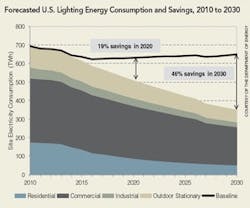LEDs Pose Growing Competition to Conventional Lighting
White-light LEDs are poised to compete with conventional lighting sources in many applications due to generally high quality and cost-effective performance, according to a recent DOE forecast.
By modeling the U.S. lighting market through 2030, DOE researchers compared annual lighting energy consumption between two scenarios: a marketplace with a growing LED presence vs. a baseline scenario where LEDs had not achieved any additional market penetration.
Working under the assumption that purchasing decisions are dominated by parameters such as first cost and annual O&M costs, the team predicted that LED lighting will gain significant market penetration if it meets the study’s estimated efficacy, lifetime, and price targets.
Energy savings from increased LED adoption could grow to about 300 terawatts (TWh) by 2030, equivalent to the output of roughly 50 power plants supplying 1,000 megawatts of electricity annually.
In 2030 alone, this would save the equivalent of about $30 billion at today’s energy prices.
The cumulative site energy savings over the 20-year forecast are estimated at about 2,700 TWh, around $250 billion in today’s prices. If the electric power plant generating mix remains the same until 2030, the energy savings would avoid the emission of about 1.8 billion metric tons of carbon.
The study, Energy Savings Potential of Solid-State Lighting in General Illumination Applications, incorporates assumptions of projected efficacy, retail price, and operating life of LED, incandescent, halogen, fluorescent, and high intensity discharge (HID) lighting.
The estimated values were based on a collaboration between DOE and the Next Generation Lighting Industry Alliance, a working group managed by the National Electrical Manufacturers Association.
